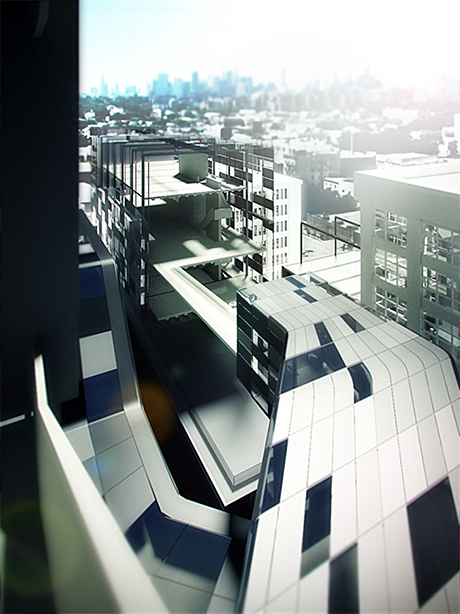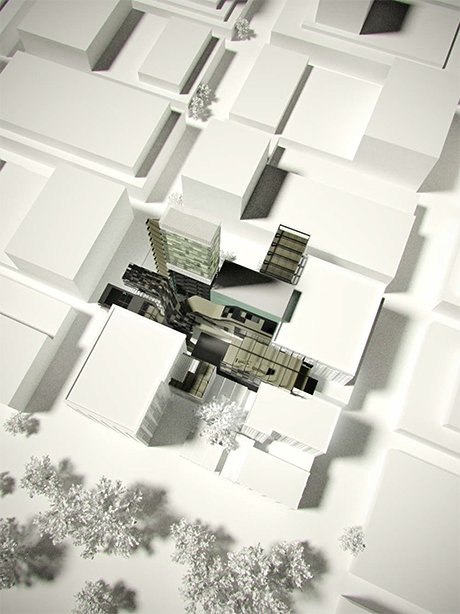Experiments in Motion is a research collaborative between Columbia University Graduate School of Architecture, Planning and Preservation in partnership with Audi of America exposing partis between motion, mobility and design. and Marc Moukarzel challenge the notion of urban densification by layering the city’s streets in multiple axes. NYC city takes on the look of “The Fifth Element”, as they challenge NYC’s Urban sprawl and push its grid vertical. Through their case study they are challenged with the notion pedestrian foot traffic, the violence of vehicular traffic, and the expansion of the urban footprint. Check it out after the jump!
STUDENTs: and Marc Moukarzel
SCHOOL: Columbia University GSAPP & Audi of America
COMPANY:
COURSE: EXPERIMENTS IN MOTION
YEAR: 2012
After the Street from Mengyi Fan on Vimeo.
‘Beyond the Street‘
“As the city grows, land values increase, often resulting in urban sprawl. Rethinking the street as potential buildable space allows the traditional urban fabric to be redirected. Just as Rem Koolhaas argued that the invention of the elevator allowed urban space to exist on a new vertical axis, so too can a reconception of the street allow for mobility in multiple axes.
With a projected total of 9.1 million people in 2030, New York City continues to grow. With growth comes eventual increases in land value. In order to prevent sprawl, one alternative will be increased densification. However, through densification eventually the existing buildable floor area ratio (FAR) will be maximized. What then?
One of the possible scenarios is to look at the street as unexploited buildable space. Beyond the Street uses the Tribeca area near the Holland Tunnel as a case study, focusing on a crucial intersection between various modes of pedestrian and vehicular traffic. In this case, how can the street be utilized as built space?
It can be tied back to the development of the built space, more specifically, the development of the skyscraper in New York. As described by Rem Koolhaas in Delirious New York, the innovation of the elevator allowed for urban space to operate on a new vertical axis. This new verticality also led to the relationship between the reproduction of floor slabs and the juxtapositive nature of the programs on each floor.
 If the street is approached in a similar way, how can its identity be reinforced through juxtaposition and reproduction?
If the street is approached in a similar way, how can its identity be reinforced through juxtaposition and reproduction?
The street is pulled apart and compress multiple situations into a single space rather than defining a megablock. If the skyscraper and its related zoning laws and incentives were developed as a result of vertical expansion, then the street deals with horizontal expansion. if the block is deemed as private ownership, then the street is a communal relationship.

If the scenario is explored as a masterplan with many collaborators, then it could also convey a new rethinking of zoning laws. As an incentive, owners and developers give back street space to build or expand into it. It is not just an incentive, it also creates new social spaces and improves quality of life on a scale relative to the multiplicity of the street.
It also changes frontage relationships. While there are precedents in Asia, for example the mixed use buildings in Tokyo, there is still only one means of access, a single frontage. No longer would we be bound by the convention of ground level storefronts with residential/offices above. instead there will be new increased juxtapositions of program with new points of access.
Densification then does not mean removing the street, but rather multiplying the street. Due to this multiplicity, the traditional definition of the street is no longer valid as they can begin to take on more functions as a connection space. Existing cores and support spaces can be combined into new shared centers in order to free up floor area to its maximum within the block buildings. New streets do not replace old ones and require only the minimum footprint to support new sandwiched structures, using new structural innovations to support their loads via existing buildings.”
- Mengyi Fan and Marc Moukarzel
Follow Mengyi Fan and Marc Moukarzel:
All Images and Text via:









Pingback: Mengyi + Marc. Spring 2012. Thesis Special* // COLUMBIA | SUPER // ARCHITECTS